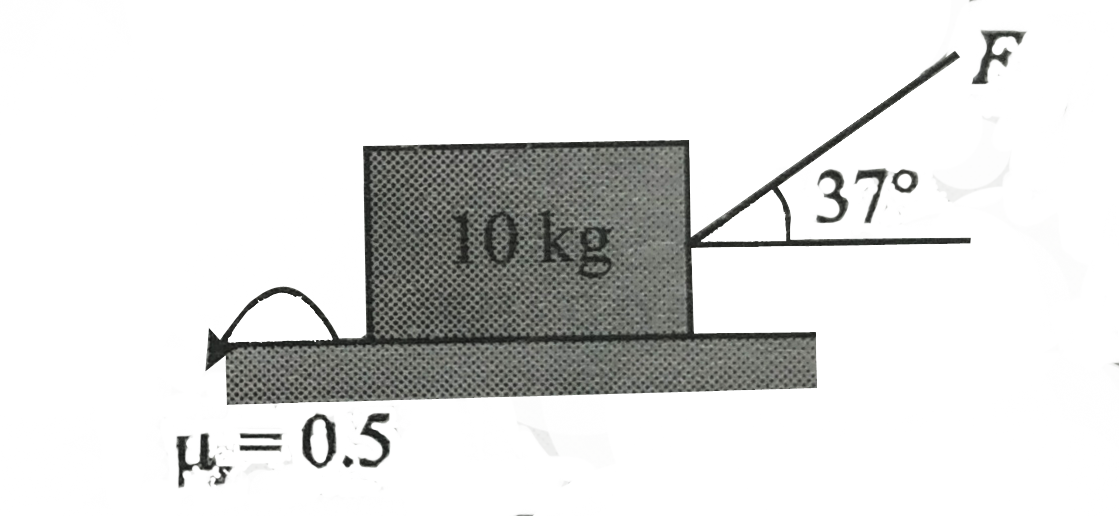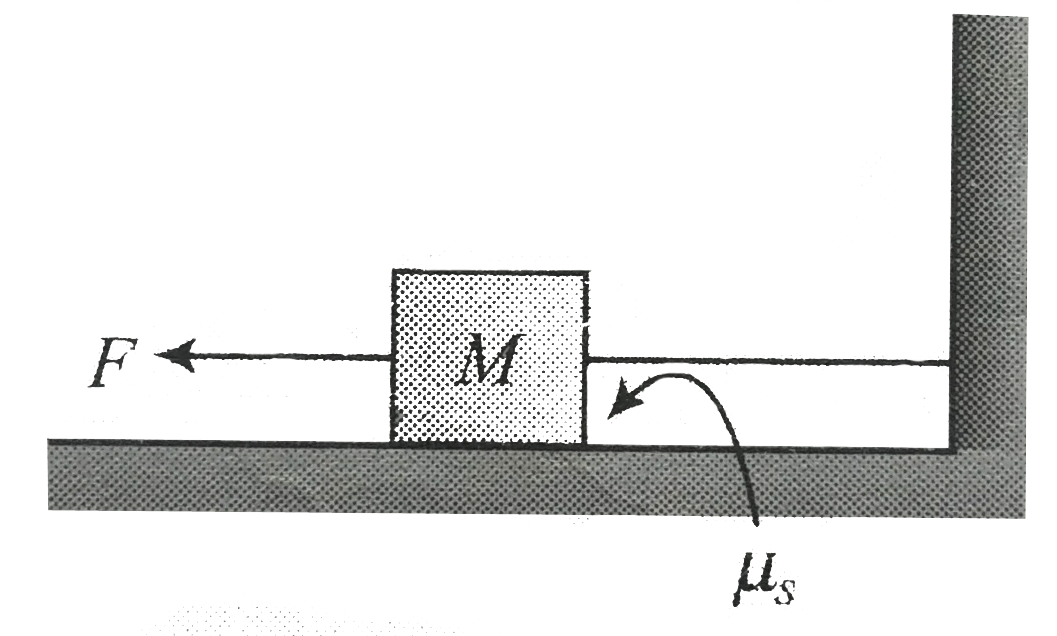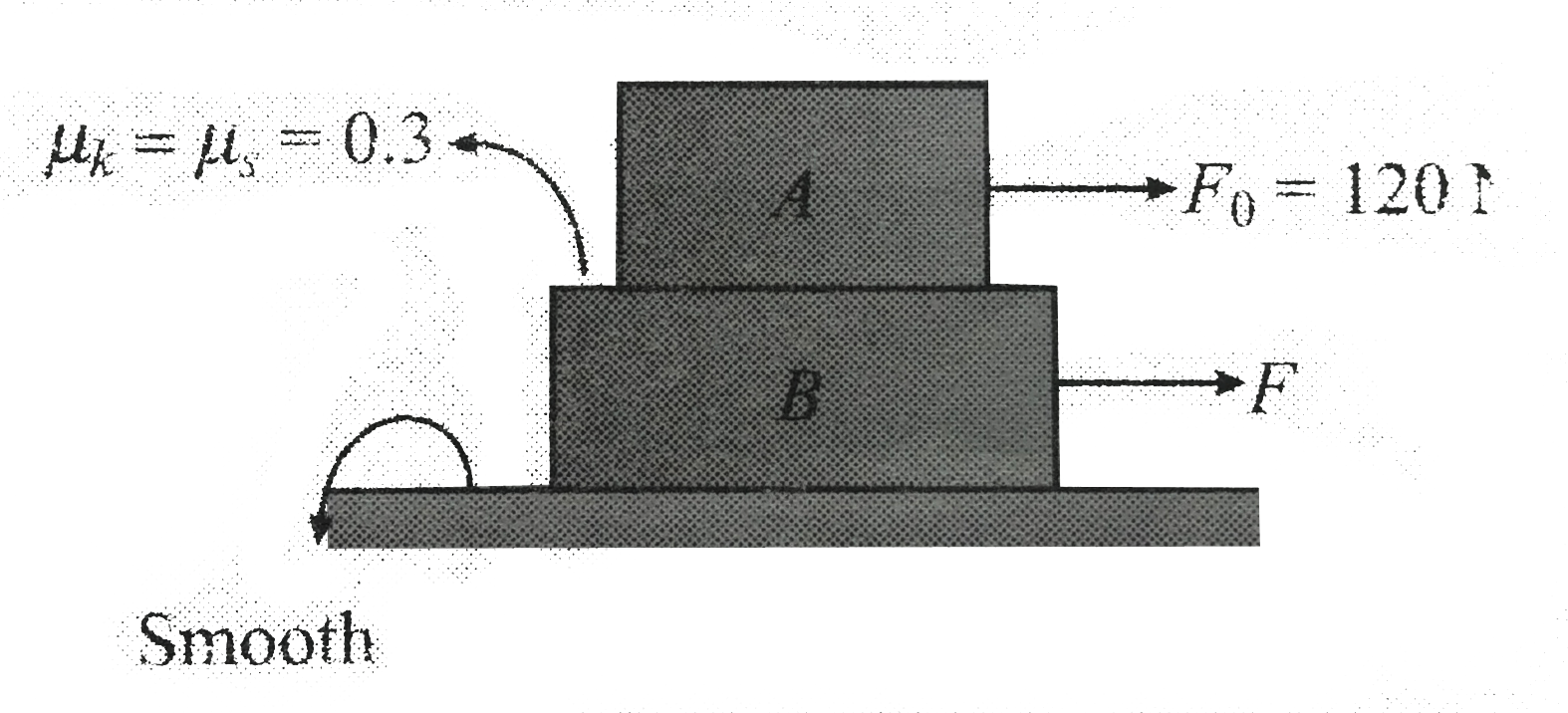Force F is graduallly increased from zero .Determine whether the block will first slide or lift up?

There is minimum magnitude of force required both in horizontal and verticle direction either to side ao lift up the block will first slide or lift up will depend apon which miximum magnitude of force is lesser

For verticle to start litting up
Fsin37∘+N≥Mg
N becomes zero just lifting condition
F≥Mgsin37∘
Flift≥10g3/5orFlift≥5003N
For horizontal direction to starrt sliding
Fcos37∘≥μsN
Fcos37∘>0.5[10g−Fsin37∘]
(∵N=10g−Fsin37∘)
Hence Fslide>50cos37∘+0.5sin37∘
Fslide>50011N
Flift>5003⇒Fslide<Flift
Topper's Solved these Questions
- NEWTON'S LAWS OF MOTION 2BOOK - CENGAGE PHYSICS ENGLISHCHAPTER - NEWTON'S LAWS OF MOTION 2EXERCISE - Solved Examples
12 Videos
- NEWTON'S LAWS OF MOTION 2BOOK - CENGAGE PHYSICS ENGLISHCHAPTER - NEWTON'S LAWS OF MOTION 2EXERCISE - Exercise 7.1
25 Videos
- NEWTON'S LAWS OF MOTION 1BOOK - CENGAGE PHYSICS ENGLISHCHAPTER - NEWTON'S LAWS OF MOTION 1EXERCISE - Integer
5 Videos
- PROPERTIES OF SOLIDS AND FLUIDSBOOK - CENGAGE PHYSICS ENGLISHCHAPTER - PROPERTIES OF SOLIDS AND FLUIDSEXERCISE - INTEGER_TYPE
2 Videos
Similar Questions
A block is being pulled by a force F on a long frictionless level floor. Magnitude of the force is gradually increases from zero until the block lifts off the floor. Immediately before the block leaves the floor, its acceleration is

View SolutionIn Fig force F is gradually increased from zero Draw the graph between applied force F and tension T is the string . The coefficient of string friction between the block and the ground is μs

View SolutionTwo blocks A and B of mass 10kg and 20kg respectivelly, are arranged as shown in figure In the figure given a constant force F0=120Nact on block A and a force F applied horizontally on block B is gradually increased from zero. Discuss the direction and nature of friction force and the acceleations of the block for different value of F

View Solution
A block A (5kg) rests over another block B (3kg) placed over a smooth horizontal surface. There is friction between A and B. A horizontal force F1 gradually increasing from zero to a maximum is supplied to A so that the blocks move together without relative motion. Instead of this another horizontal force F2, gradually increasing from zero to a maximum is supplied to B so that the blocks move together without relative motion. Then
View SolutionIn the figure shown, horizontal force F1 is applied on a block but the block does not slide. Then as the magnitude of vertical force F2 is increased from zero the block begins to slide, the correct statement is

View SolutionFor the potential energy curve shown in figure.
(a) Determine whether the force Fx is positive, negative, or zero at the five points indicated, (b) Indicate points of stable, unstable, and neutral equilibrium, (c) Sketch the curve for Fx versus x from x=0 to x=8m.

View SolutionIn the figure shown,
(a) find the force of friction acting on the block.
(b) state whether the block will move or not. If yes then with what acceleration?

View SolutionIn the figure shown,
(a) find the force of friction acting on the block.
(b) state whether the block will move or not. If yes then with what acceleration?

View SolutionA block is kept on a rough surface and applied with a horizontal force as shown which is gradually increasing for zero. The coefficient of static and kinetic friction are 1/√3 then

View Solution A block of mass m is placed on a rough inclined plane. The corfficient of friction between the block and the plane is μ and the inclination of the plane is θ.Initially θ=0 and the block will remain stationary on the plane. Now the inclination θ is gradually increased . The block presses theinclined plane with a force mgcosθ. So welding strength between the block and inclined is μmgcosθ, and the pulling forces is mgsinθ. As soon as the pulling force is greater than the welding strength, the welding breaks and the blocks starts sliding, the angle θ for which the block start sliding is called angle of repose (λ). During the contact, two contact forces are acting between the block and the inclined plane. The pressing reaction (Normal reaction) and the shear reaction (frictional force). The net contact force will be resultant of both.
A block of mass m is placed on a rough inclined plane. The corfficient of friction between the block and the plane is μ and the inclination of the plane is θ.Initially θ=0 and the block will remain stationary on the plane. Now the inclination θ is gradually increased . The block presses theinclined plane with a force mgcosθ. So welding strength between the block and inclined is μmgcosθ, and the pulling forces is mgsinθ. As soon as the pulling force is greater than the welding strength, the welding breaks and the blocks starts sliding, the angle θ for which the block start sliding is called angle of repose (λ). During the contact, two contact forces are acting between the block and the inclined plane. The pressing reaction (Normal reaction) and the shear reaction (frictional force). The net contact force will be resultant of both.
Answer the following questions based on above comprehension:
Q. For what value of θ will the block slide on the inclined plane:
View Solution
